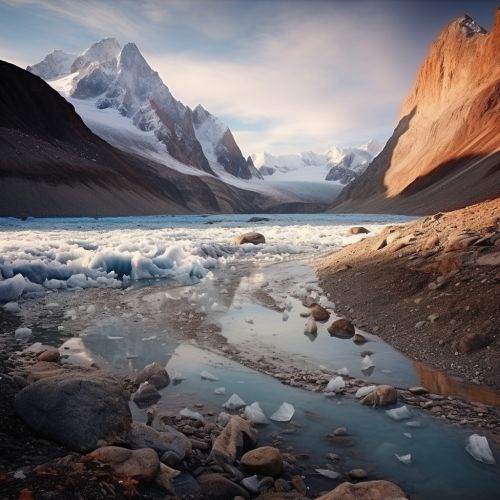Moraine
Definition and Formation
A moraine is a mass of rocks and sediment carried down and deposited by a glacier, typically as ridges at its edges or extremity. The formation of a moraine is a complex process that involves the interaction of glaciers with the underlying bedrock and the surrounding environment. This process is influenced by a variety of factors, including the size and velocity of the glacier, the characteristics of the bedrock, and the climate conditions.
Glaciers are massive bodies of ice that move slowly over land, driven by the force of gravity. As they move, they erode the underlying bedrock and incorporate the eroded material into the ice. This material, which includes rocks, boulders, and sediment, is transported by the glacier and eventually deposited as a moraine.
The formation of a moraine begins when a glacier erodes the underlying bedrock. This process, known as glacial erosion, involves two main mechanisms: abrasion and plucking. Abrasion occurs when the glacier grinds against the bedrock, wearing it away and producing fine sediment. Plucking, on the other hand, involves the removal of larger pieces of rock from the bedrock.
As the glacier moves, the eroded material is incorporated into the ice and transported downstream. This material is concentrated at the edges and the terminus of the glacier, where it is eventually deposited as a moraine. The size and shape of the moraine depend on the amount of material transported by the glacier and the rate at which it is deposited.


Types of Moraines
There are several types of moraines, each with its own unique characteristics and formation processes. These include lateral moraines, medial moraines, terminal moraines, and recessional moraines.
Lateral Moraines
Lateral moraines are ridges of debris that form along the sides of a glacier. They are composed of material that has been eroded from the valley walls by the glacier and incorporated into the ice. As the glacier moves, this material is transported and deposited at the edges of the glacier, forming a lateral moraine.
Medial Moraines
Medial moraines are formed when two glaciers merge and the lateral moraines on the inner sides of the glaciers combine. The resulting moraine runs down the center of the merged glacier, forming a distinctive stripe of debris.
Terminal Moraines
Terminal moraines are ridges of debris that form at the terminus, or end, of a glacier. They represent the furthest point reached by the glacier during its most recent period of advance. Terminal moraines are often larger and more prominent than other types of moraines due to the large amount of material deposited at the glacier's terminus.
Recessional Moraines
Recessional moraines are ridges of debris that form at points where a retreating glacier paused in its retreat. They are similar to terminal moraines, but they are often smaller and less prominent.
Importance of Moraines
Moraines are important features in the study of glaciology and geomorphology. They provide valuable information about the past behavior of glaciers, including their size, velocity, and direction of movement. By studying moraines, scientists can reconstruct the history of glaciation in a particular area and gain insights into past climate conditions.
In addition, moraines play a crucial role in shaping the landscape. They contribute to the formation of various landforms, including hills, valleys, and plains. They also influence the flow of water in a landscape, affecting the formation and behavior of rivers and lakes.
Furthermore, moraines are important sources of sediment. The rocks and sediment deposited by glaciers are often rich in nutrients, making them valuable for agriculture. In some areas, moraines are mined for gravel and other construction materials.
